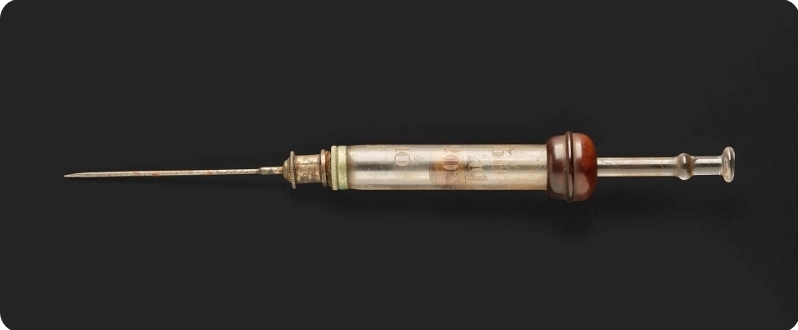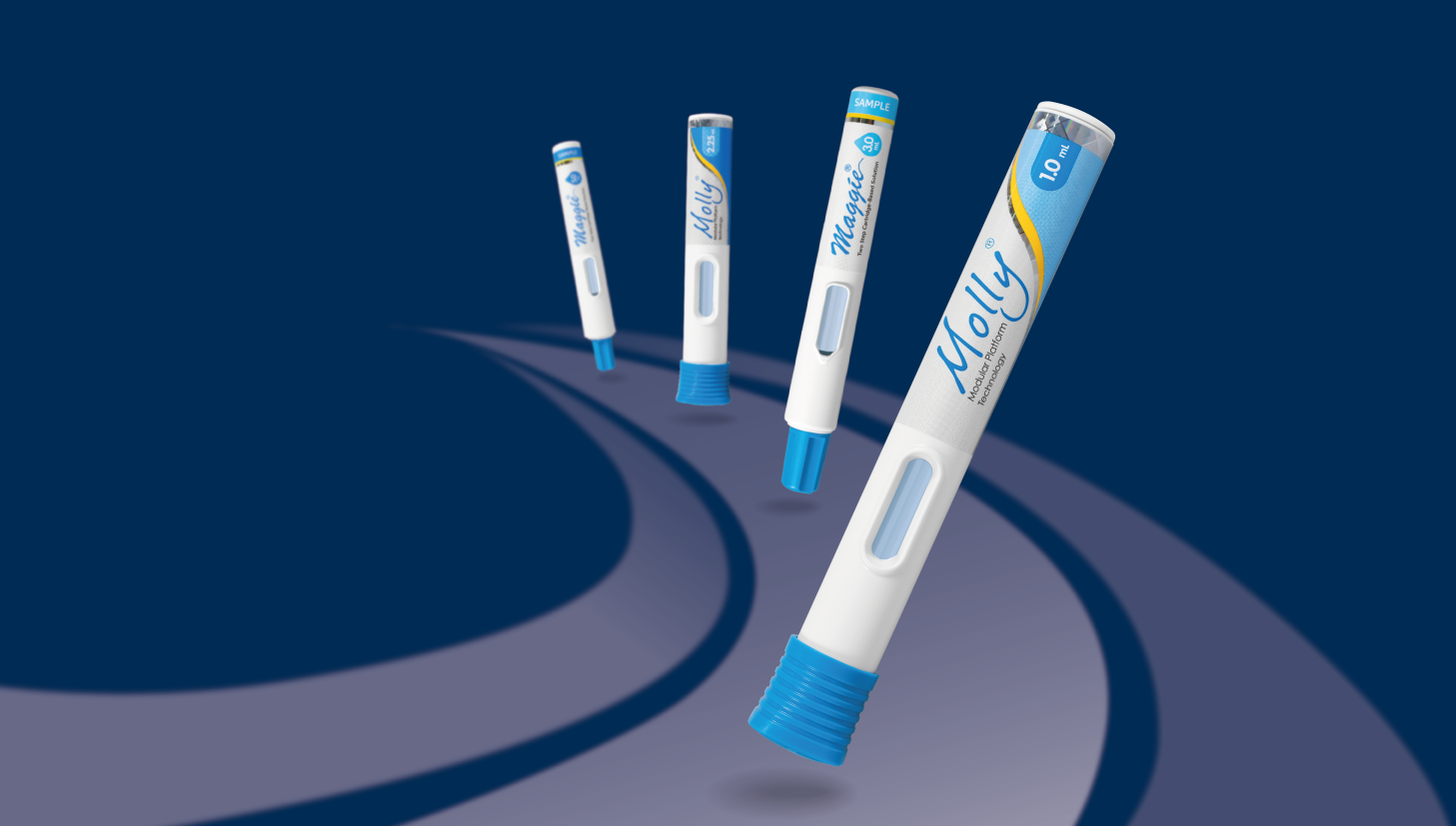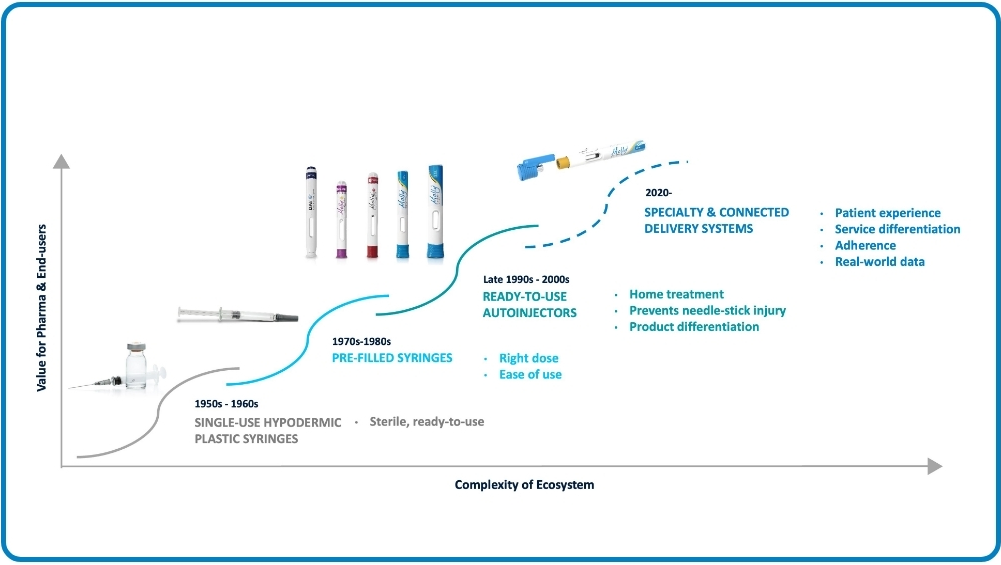What did humans use before the invention of autoinjectors?
December 24 2024
A historical overview of the modernization of autoinjectors
The past two decades have seen a significant rise in autoinjectors, driven by the increasing demand for self-injection treatments. To fully appreciate this innovation, it is worth exploring the history of injection practices, starting with the inventions of the syringe and hypodermic needle.
Before reaching today’s advanced subcutaneous autoinjectors, early pioneers in medicine first had to solve two critical challenges: developing a tool capable of delivering medication into the body and designing a transport channel that was thin enough to penetrate the skin without causing significant harm. These breakthroughs laid the groundwork for the modern autoinjectors that we rely on today – a topic we explore further in this second installment of our “Back to Basics” series.
Inventions of the hypodermic needle and the syringe
Injections have come a long way. The earliest documented references to injection-like methods date back to the first century in Roman and Greek literature, where surgeons used hollow reeds to administer ointments or cream into human orifices1.
Fast forward to 1650, French mathematician and physicist Blaise Pascal invented the first rudimentary syringe—completely different from the syringes we recognize today—while he was experimenting with hydrodynamics, introducing a revolutionary method for delivering medicines2.
Shortly afterwards, architect Christoper Wren expanded on the idea by conducting an unconventional experiment: injecting wine into his dog’s veins through animal bladder and quill. While groundbreaking at the time, these early experiments eventually led to bold—and ultimately fatal—attempts on the human subjects.
It was not until the 19th century when Irish doctor Francis Rynd invented the needle for human use did the idea of medicine injections resurface. In a major breakthrough, Rynd invented the hypodermic needle—a thin, hollow instrument capable of penetrating the skin and delivering medication below the skin surface, paving the path for modern injection techniques3.
Building on Rynd’s invention, Scottish doctor Alexander Wood made another leap forward in 1850 by attaching the thin, hollow needle to a plunger, creating a syringe mechanism remarkably similar to the one we use today. This advancement set the stage for the development of autoinjectors.
 Figure 1: An image of the oldest syringe said to have been used by Dr. Alexander Wood4
Figure 1: An image of the oldest syringe said to have been used by Dr. Alexander Wood4
The rise of self-injections
Following the invention of Wood’s syringe with a staked needle, self-injections came onto the scene through the traditional vial-and-syringe method. Patients would draw medicine from vials using a syringe, then penetrate the skin and push the plunger to administer the medication with the same syringe.
The introduction of the pre-filled syringe came at a later stage, during World War II in the 1940s, when medication required fast and uncontaminated transportation to battlefield hospitals. These glass containers, pre-filled with the required dosage and equipped with staked needles, eliminated the need for soldiers and medics to draw medicine from vials. This innovation simplified the injection procedure, requiring only the removal of the needle cover before administration.
As shown in historical examples like the Wyeth Syringe Case below (Figure 3), the pre-filled glass containers with staked needles contained medication such as morphine, distilled water, and meperidine. As such, wounded soldiers were able to self-administer the pain relief while awaiting medical assistance in the field.

Figure 2: The Wyeth Syringe case that soldiers carried to wars helped them ease their pain while waiting for help5
Self-injection with autoinjectors
The origins of the autoinjector can be traced back to the 1970s, when it found its initial use in emergency situations, such as military chemical warfare and epinephrine delivery. During the Cold War, soldiers carried emergency kits equipped with antidote autoinjectors designed to counteract nerve gas exposure.

Figure 3: MARK I nerve agent antidote kit. The kit contains two autoinjectors filled with different kinds of nerve agent antidotes6
This same principle of rapid, self-administered treatment inspired Sheldon Kaplan to develop the EpiPen — an epinephrine autoinjector designed to manage anaphylaxis. Approved by the FDA in 1987, the EpiPen became the cornerstone of modern emergency medicine by making life-saving interventions accessible to both patients and first responders.

Figure 4: Image of EpiPen7
Modernization of autoinjectors
Following the introduction of autoinjectors for emergency uses, the mid-2000s saw the rise of the development of autoinjectors for non-emergency and home uses. Between those years, self-injections were mostly done through pen injectors. The modernized autoinjectors were primarily aimed at treating chronic diseases, allowing patients to self-inject medication at home under a doctor’s prescription.
This evolution highlights how autoinjectors have transitioned from addressing a relatively rare instance of emergency cases to becoming a critical tool for managing a wide range of chronic diseases. Modern, single-use autoinjectors are streamlined for ease of use, featuring simple procedures such as a two-step “uncap and push” or a three-step “uncap, push, and press button”. These advancements prioritize user-friendly functionality into the designs, making self-administration more accessible and convenient for patients.
Amongst these innovations is SHL Medical’s DAI® (Disposable Autoinjector). The sleek, glossy design of the DAI autoinjector immediately sets it apart from its bulky, emergency-use predecessors. The first combination product supported by the DAI received FDA approval and was launched in 2006, a few years ahead of other competing products at that time.
In the years that followed, the DAI went on to deliver more than 20 commercial products for SHL Medical’s pharma partners. The DAI also involved a nearly two-decade-long-patent battle, a testament to the device’s significance and the innovation it represents. SHL Medical’s ultimate victory reinforced the importance of the DAI in the autoinjector market, as evidenced by the attempt to challenge the patent protecting the DAI.

Figure 5: The DAI® – Disposable Autoinjector earned the 2006 Taiwan Excellence Award, helping establish SHL Medical as a market leader
Following the commercialization of multiple DAI projects, SHL Medical continued to expand our device portfolio by developing other autoinjectors, including Molly®, Maggie®, and Elexy™, among others. This relentless pursuit of innovation has enabled us to support the launch of more than 50 combination products to date, firmly establishing our position as a leader in the industry.
Leading up to present
The autoinjector industry continues to grow, driven by the rise of new biologic drugs, many of which are designed for subcutaneous administration. This growth has pushed autoinjector developers to prioritize the integration of more patient-centric elements into their devices.
SHL Medical’s devices, such as the Molly Connected Cap and Maggie 5.0 autoinjectors, are some examples of this emerging trend. The Molly Connected Cap demonstrates how platform technology can support the transition to connected healthcare. Leveraging the power of digitalization, patients can track their injection times without the need for manual logging, while healthcare providers can remotely monitor patients’ injection records to assess the efficacy of their treatments.
Figure 6: The evolution of the self-injection treatment
Similarly, the Needle Isolation Technology (NIT®)-enabled Maggie autoinjectors are developed to address the growing demand for large-volume injection solutions. With more pharma and biotech companies seeking to reduce injection frequency through higher-doses treatments, Maggie autoinjectors offer an effective and patient-friendly approach to administering large-volume biologic therapies.
References:
1. A history of syringes and needles. (2024, June 27). Faculty of Medicine - University of Queensland. https://medicine.uq.edu.au/blog/2018/12/history-syringes-and-needles
2. Syringe | device | Britannica. (n.d.). Encyclopedia Britannica. https://www.britannica.com/technology/syringe
3. Medshop Editor. (2020, May 31). The History of the Hypodermic Needle — Evolution with a Point! Medshop. https://www.medshop.com.au/blogs/news/history-with-a-point-the-evolution-of-the-hypodermic-needle
4. Science and Technology. (n.d.). The story of syringes. National Museums Scotland. https://www.nms.ac.uk/explore-our-collections/stories/science-and-technology/syringes/
5. Case, W. S. (2019). Wyeth Syringe Case. STARS.
https://stars.library.ucf.edu/kaplan-images/71/
6. Wikipedia Contributors. (2024, May 22). Mark I NAAK. Wikipedia; Wikimedia Foundation.
7. F.D.A. approves generic Epipen that may be cheaper. (2018, August 16). The New York Times. https://www.nytimes.com/2018/08/16/health/epipen-generic-drug-prices.html
8. Whelton, R. (2023, November 13). Autoinjectors: Historical achievements & compelling needs driving next-generation devices. ONdrugDelivery.
https://www.ondrugdelivery.com/autoinjectors-historical-achievements-compelling-needs-driving-next-generation-devices/

